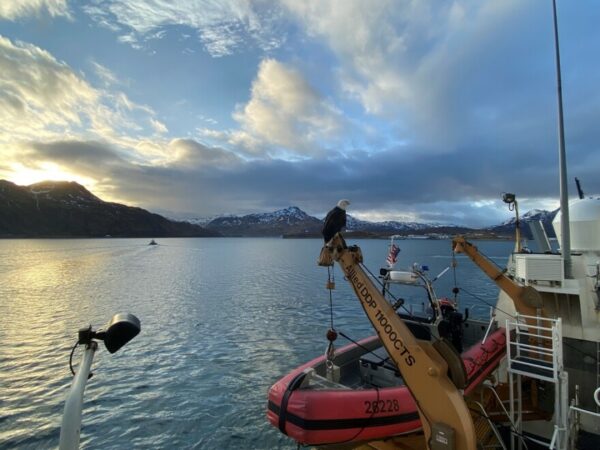
A U.S. Coast Guard cutter and its 140 crew members returned to California late last month after a nearly 80-day patrol in the Bering Sea.
The 418-foot Waesche — a vessel longer than a football field — traveled more than 12,000 miles since departing Alameda in November. Its patrol spanned the West Coast, Bering Sea, Aleutian Islands and Gulf of Alaska.
During its more than two months at sea, the national security cutter and its crew served as the “ready asset” for homeland defense and search-and-rescue operations, supporting the nearly $6 billion commercial fishing industry, according to a Coast Guard statement.
Lt. Cmdr. Keith Blevins has been with the Waesche since May of last year. He said the Coast Guard sends its most valuable assets to Alaska, given the state’s strategic location and booming fishing industry.
“What’s the place that the Coast Guard has a cutter 365 [days a year] with a helicopter ready to respond? There’s one spot in the world where we’re always ready, and it’s Alaska,” Blevins said in a phone interview from his home in Alameda.
There’s always a Coast Guard ship in Bering Sea waters, said Blevins. When one leaves, another heads north to Alaska.
During the Waesche’s most recent patrol, it enforced fishing regulations among Bering Sea fleets and monitored the U.S.–Russian Maritime Boundary Line.
It also conducted “rigorous training exercises,” said the Coast Guard statement.
Those training exercises included practicing rescuing mariners in distress by using a helicopter to hoist a mannequin from the deck of the cutter, as if they were rescuing a fisherman from a vessel underway at sea, Blevins said.
The Waesche helped with two medevacs from the Aleutians during its patrol.
The crew also focused on boat operations and boat crew training in Alaska’s rough weather and seas, Blevins said.
“You can launch a boat on a beautiful sunny day in San Francisco or Alameda, and that is nothing compared to Alaska,” he said. “So you don’t just launch the boat on a bright and sunny day for training. You launch on a day where the winds may be gusting up to 30 knots and it may be dark so that way if we had to launch and go assist fishermen, the first time you’re launching the boat in bad weather is not the time that you’re having a search or rescue case.”
The Russian Navy has beefed up its presence in the Arctic in recent years as sea ice melts and economic opportunities open with new shipping lanes, prompting increased attention from American military observers.
The Waesche is the second of eight planned national security cutters, according to the Coast Guard. The large, technologically advanced fleet is capable of executing “the most challenging operations, including supporting maritime homeland security and defense missions,” said the agency.
“We are the prevention of adversaries coming into our waters,” Blevins said. “The Waesche and/or other ships will go up and patrol the maritime boundary line between us and Russia. Last summer, we had the Chinese strike group come into the Aleutian Chain and they were met by Coast Guard national security cutters. We are always there for those crises as well.”
On average, cutters spend about 185 days away from their homeport, according to Blevins. He said the Waesche is expected to stay in Alameda for a bit for maintenance before heading back out on patrol.
[Sign up for Alaska Public Media’s daily newsletter to get our top stories delivered to your inbox.]




